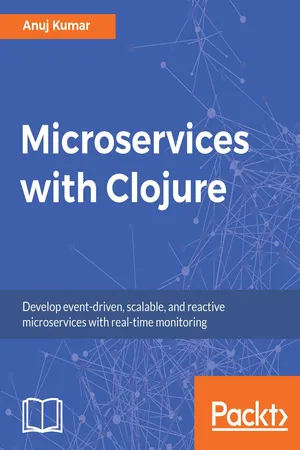
- 336 pages
- English
- ePUB (mobile friendly)
- Available on iOS & Android
Microservices with Clojure
About this book
The common patterns and practices of the microservice architecture and their application using the Clojure programming language.About This Book• Relevance of the microservice architecture and benefits of Clojure's functional and simple features to implement it.• Learn best practices and common principles to avoid common pitfalls while developing microservices.• Learn how to use Pedestal to build your next microservices, secure them using JWT, and monitor them using the ELK stackWho This Book Is ForYou should have a working knowledge of programming in Clojure. However, no knowledge of RESTful architecture, microservices, or web services is expected. If you are looking to apply techniques to your own projects, taking your first steps into microservice architecture, this book is for you.What You Will Learn• Explore the pros and cons of monolithic and microservice architectures• Use Clojure to effectively build a reallife application using Microservices• Gain practical knowledge of the Clojure Pedestal framework and how to use it to build Microservices• Explore various persistence patterns and learn how to use Apache Kafka to build event-driven microservice architectures• Secure your Microservices using JWT• Monitor Microservices at scale using the ELK stack• Deploy Microservices at scale using container orchestration platforms such as KubernetesIn DetailThe microservice architecture is sweeping the world as the de facto pattern with which to design and build scalable, easy-tomaintain web applications. This book will teach you common patterns and practices, and will show you how to apply these using the Clojure programming language.This book will teach you the fundamental concepts of architectural design and RESTful communication, and show you patterns that provide manageable code that is supportable in development and at scale in production. We will provide you with examples of how to put these concepts and patterns into practice with Clojure. This book will explain and illustrate, with practical examples, how teams of all sizes can start solving problems with microservices.You will learn the importance of writing code that is asynchronous and non-blocking and how Pedestal helps us do this. Later, the book explains how to build Reactive microservices in Clojure that adhere to the principles underlying the Reactive Manifesto. We finish off by showing you various ways to monitor, test, and secure your microservices. By the end, you will be fully capable of setting up, modifying, and deploying a microservice with Clojure and Pedestal.Style and approachThis book highlights the merits of the microservice architecture and its implementation with Clojure. Learn to implement microservices by migrating a monolithic application to a microservice-based architecture.
Frequently asked questions
- Essential is ideal for learners and professionals who enjoy exploring a wide range of subjects. Access the Essential Library with 800,000+ trusted titles and best-sellers across business, personal growth, and the humanities. Includes unlimited reading time and Standard Read Aloud voice.
- Complete: Perfect for advanced learners and researchers needing full, unrestricted access. Unlock 1.4M+ books across hundreds of subjects, including academic and specialized titles. The Complete Plan also includes advanced features like Premium Read Aloud and Research Assistant.
Please note we cannot support devices running on iOS 13 and Android 7 or earlier. Learn more about using the app.
Information
Building Microservices for Helping Hands
- Implement Hexagonal design for microservices
- Create scalable microservices for Helping Hands using Pedestal
- Implement workflows for microservices using the Pedestal interceptor chain
- Implement the lookup service of Helping Hands to search for services and generate reports
Implementing Hexagonal Architecture

Designing the interceptor chain and context
- Auth: Used to authenticate and authorize requests received by the API endpoints exposed by the microservice.
- Validation (data model): Used to validate the request parameters and map the external data model with the internal data model as expected by the business logic and underlying persistent store.
- Business logic: One or more interceptors to implement the business logic. These interceptors process the request parameters received by the API endpoints.
- Persistence: Persist the changes using one or more adapters that implement the Port Protocol defined for the microservice data model to be persisted.
- Events: Generate events asynchronously both for other microservices as well as for monitoring and reporting. These interceptors are added at the end of the chain to generate changelog events of the persistent store for other microservices to consume.
Creating a Pedestal project
(defproject helping-hands "0.0.1-SNAPSHOT"
:description "Helping Hands Application"
:url "https://www.packtpub.com/application-development/microservices-clojure"
:license {:name "Eclipse Public License"
:url "http://www.eclipse.org/legal/epl-v10.html"}
:dependencies [[org.clojure/clojure "1.8.0"]
[io.pedestal/pedestal.service "0.5.3"]
;; Remove this line and uncomment one of the next lines to
;; use Immutant or Tomcat instead of Jetty:
[io.pedestal/pedestal.jetty "0.5.3"]
;; [io.pedestal/pedestal.immutant "0.5.3"]
;; [io.pedestal/pedestal.tomcat "0.5.3"]
[ch.qos.logback/logback-classic "1.1.8" :exclusions [org.slf4j/slf4j-api]]
[org.slf4j/jul-to-slf4j "1.7.22"]
[org.slf4j/jcl-over-slf4j "1.7.22"]
[org.slf4j/log4j-over-slf4j "1.7.22"]]
:min-lein-version "2.0.0"
:source-paths ["src/clj"]
:java-source-paths ["src/jvm"]
:test-paths ["test/clj" "test/jvm"]
:resource-paths ["config", "resources"]
:plugins [[:lein-codox "0.10.3"]
;; Code Coverage
[:lein-cloverage "1.0.9"]
;; Unit test docs
[test2junit "1.2.2"]]
:codox {:namespaces :all}
:test2junit-output-dir "target/test-reports"
;; If you use HTTP/2 or ALPN, use the java-agent to pull in the correct alpn-boot dependency
;:java-agents [[org.mortbay.jetty.alpn/jetty-alpn-agent "2.0.5"]]
:profiles {:provided {:depend...
Table of contents
- Title Page
- Copyright and Credits
- Dedication
- Packt Upsell
- Contributors
- Preface
- Monolithic Versus Microservices
- Microservices Architecture
- Microservices for Helping Hands Application
- Development Environment
- REST APIs for Microservices
- Introduction to Pedestal
- Achieving Immutability with Datomic
- Building Microservices for Helping Hands
- Configuring Microservices
- Event-Driven Patterns for Microservices
- Deploying and Monitoring Secured Microservices
- Other Books You May Enjoy